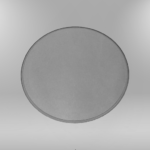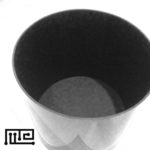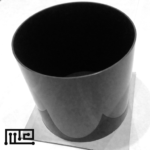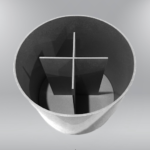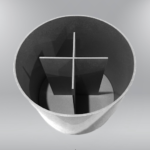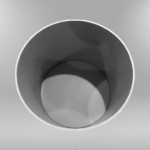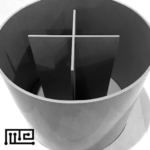Product Info
Cirular open fields are a variant of the typical square open field. The new, popular variant lacks corners as a confounding variable and creates more centralized open field space for exploration and novelty seeking. The typical open field center and more sheltered perimeter of such fields are used to examine the effects of drugs, sex differences, and illumination on the behavioral expression of fear and anxiety.
- Walls can be both opaque or clear. We recommend that clear walls are used for measurements of anxiety, while opaque walls are used if assessments include novel object recognition.
- Walls are easily detachable for easy cleaning.
- Grid floor insert available for video tracking.
Our Open Field is compatible with all major video tracking and analysis packages including our complete tracking and analysis package ConductVision,Noldus Ethovision XT,and ANY-Maze.
Mouse
$ 1590
+ Shipping and Handling (approx $100)- 40cm diameter
- 30cm height
- Removable base for easy clean
- Acrylic
- Easy clean with 70% Ethanol
- Matte Finish for non shine
- No odors
Rat
$ 1990
+ Shipping and Handling (approx $150)- 60cm diameter
- 40cm height
- Removable base for easy clean
- Acrylic
- Easy clean with 70% Ethanol
- Matte Finish for non shine
- No odors
Documentation
Introduction
The Circular Open Field is a circular shaped open arena with high opaque or transparent walls. Open Fields are popularly used in the assessment of anxiety-related and exploratory behaviors. The circular field is a modification of the widely used Open field maze. The corners of these arenas tend to add a confounding variable when analyzing data since they can serve as safe spaces. Further, the global geometry of the arena can also act as an influencing factor in memory and navigation tasks.
For more anxiety and depression related assays, click here. For exploration assays, click here.
Apparatus and Equipment
The Circular Open Field is constructed using acrylic, which is available in both transparent and opaque constructions. The arena has a diameter of 40 cm and a wall height of 30 cm. The apparatus is also available in diameter 60 cm and height 40 cm for larger rodents. The base of the arena is removable. Grid floor insert is also available to assist with video recording.
A camera connected to tracking software such as ConductVision, Noldus Ethovision XT,and ANY-Maze can mounted above the maze assist with live scoring, tracking and recording the subject and its movements within the chamber.
Literature Review
Navigation and Exploration Behavior Studies
Investigation of the influence of arena geometry on the path traveled
Yaski, Portugali, and Eilam (2011) observed the exploratory behaviors of male Wistar rats in two Open Fields. Rats were divided into two groups; Circular Open Field and Square Open Field. Each rat was tested once in their respective arena under the dark cycle. Rats in either arena began the trial from a fixed starting point facing the center of the arena. During the 20 minutes observation period, rats in the Circular Open Field took a circuitous path when they traveled through the center of the arena. Rats in the Square Open Field had smaller turn angles in comparison to the Circular Open Field rats regardless of the length of their crosscuts.
Investigation of the temporal organization during novelty exploration
Kalueff, Keisala, Minasyan, Kuuslahti, and Tuohimaa (2006) investigated the behavioral activity, and temporal distribution of different mice strains in different Open Fields. Male and female mice of the following strains were evaluated under different experimental set-up:
- 27 males and 10 females of S1 strain (25–30 g)
- 15 males of F1 hybrid strains (7 NMRI × S1; 35–40 g and 8 BALB/c (BC) × S1; 30–35 g)
- 10 females Vitamin D receptor knockout mice (VDR KO; 20–25 g; generated on S1 background).
Open Fields used included
-
- 90 cm diameter, 50 cm high wall Circular Open Field (COF)
- 45 cm × 45 cm × 45 cm grey Square Open Field (SOF)
- 30 cm × 30 cm transparent Actimeter Open Field (AOF)
- 5.5 m × 5.5 m dimly lit isolated square room with white linoleum floor and white walls (BOF)
All experiments were initiated by placing an individual subject in the center of the arena. The strain S1 was evaluated in three experiments. For their first experiment, 3 groups of male mice were tested in parallel on the AOF, SOF, and COF in a 10-minute trial. While performances of all groups were similar in all three arenas, significantly less horizontal activity was observed in AOF in comparison to the SOF. Temporal patterning of both horizontal and vertical exploration was also extremely similar in all three arenas. In the next experiment, males first tested in the COF in a 10 minutes trial, a week after which they were evaluated in a 10-minute trial in the BOF. Mice showed more horizontal activity in the BOF though other observations and temporal patterning were quite similar. In experiment three, females underwent two 10-minute trials in the SOF separated by a week. No significant observations were made. In experiment four, males of S1 strain were compared with males of F1 hybrid NMRIS1 and BCS1. Subjects were tested in a 5-minute trial in the SOF and 30 days later, in the COF. All three strains displayed the same temporal patterning of their Open Field behaviors, and no significant strain effect could be observed in the performances. A final experiment with VDR KO versus their wild-type counterparts two 10 minutes trials in the SOF separated by a week; this was then followed three weeks later by a 5-minute trial in the COF, whose performances were compared with the first SOF trial. In the SOF trials, the VDR KO mice showed significantly lower horizontal and vertical activity. However, the temporal organization did not differ significantly between the two groups in either arena.
Investigation of exploratory behavior in different environments
Genaro and Schmidek (2000) investigated the exploratory behaviors of 9 young male Long-Evans black hooded strain rats in a Circular Open Field (OF), Circular Open Field with den (OD), and a complex environment (EX). The OD and EX consisted of a 19.5 × 30.5 × 13 cm den compartment, which could be connected to the arena via a 7.6 cm diameter and 10 cm long tunnel. Animals were habituated for 30 minutes to the den compartment prior to the trials in the corresponding arena. The EX arena consisted of ten linearly connected compartments via small tunnels or runways. Animals were divided into three groups. Each arena was tested 3 times on subsequent days with a 10-day interval between each environment tested. All tests lasted 15 minutes each. The first group (OF, OD, EX) was evaluated 30 days later with one OD and one EX test on subsequent days. Group 2 (OD, EX, OF) were tested 30 days later on each OD, EX, and OF on subsequent days. The last group was tested for the sequence EX, OF, and OD. Subjects showed significantly longer latency to leave the refuge in the OD test in comparison to the EX test. Further, subjects spent a significant amount of time exploring the EX environment as opposed to the OD environment. For OF and OD tests, subjects were observed spending a significant amount of time near the peripheral sections of the arenas. Further, distance covered in the EX tests was significantly larger than in either Open Field tests. Subjects also displayed more anxious behaviors in the OF tests in comparison to the other two arenas.
Anxiety and Stress Behavior Research
Investigation of panic-related behaviors following blockade of GABAA receptors
Male Wistar rats were divided into groups and underwent surgery for placement of a stainless-steel guide-cannula in the diencephalon targeting either the dorsomedial hypothalamus (DMH) or the posterior hypothalamus (PH) and in the midbrain aimed at the dorsal periaqueductal grey matter (dPAG). Following 5 days of recovery, animals were evaluated in a Circular Open Field and Polygonal Arena. The Polygonal Arena consisted of an artificial burrow that had two exits. Animals either received injection of The GABAA receptor antagonist [R-(R*, S*)]-5-(6,8-dihydro-8-oxofuro[3,4-e]-1,3-benzodioxol-6-yl)-5,6,7,8-tetrahydro-6,6-dimethyl-1,3-dioxolo[4,5-g]isoquinolinium iodide (Bicuculline, 40 ng/0.2 µL) or saline prior to the trials. Bicuculline microinjection into the DMH and PH nuclei resulted in intense exploratory behaviors in the Circular Open Field. Further, compared to PH and dPAG, and their saline-treated counterparts, the duration and frequency of alertness were significantly higher in the bicuculline treated DMH group. On the other hand, bicuculline resulted in significant freezing duration and frequency, as well as the frequency and duration of escape only in the dPAG group. The treatment also resulted in significant horizontal jumping frequency though the vertical jumping frequency of the dPAG group remained significantly lower than the PH and DMH groups. Bicuculline treatment resulted in higher frequency and duration of rearing in the PH and DMH groups in comparison to their saline-treated counterparts. Additionally, bicuculline also resulted in significantly higher crossings in all groups compared to their saline-treated counterparts. In the Polygonal Arena assessment, bicuculline resulted in a significant increase in the duration of alertness in all groups in comparison to their saline-treated counterparts, with the dPAG group having the highest duration among all groups. The frequency and duration of freezing were only increased significantly in the bicuculline treated dPAG group. While bicuculline treatment resulted in increased vertical jumping in only DMH and PH groups, in the dPAG group, it resulted in a significant increase in horizontal jumping and non-oriented escape behaviors. Duration of oriented escape was significantly higher in the bicuculline treated PH group in comparison to the other groups. All bicuculline groups displayed a higher number of crossings and time spent outside burrow in comparison to their saline-treated counterparts. (Biagioni et al., 2016)
Investigation of the effects of repeated maternal separation
Shalev and Kafkafi (2002) investigated the behavioral responses of Long Evan rat pups subjected to different maternal separation treatments in a Circular Open Field. Long Evan pups were divided into three groups maternal separation (MH), early handling (EH), and non-handled (NH) groups starting postnatal days 3 to 14. The EH group was separated for 15 minutes while the MS group was separated for 180 minutes from the dams in individual cages. Rats were tested under bright light conditions in the Circular Open Field at 11 weeks of age, in a 15-minute trial. The NH group displayed significant anxiety-related behaviors in the Open Field test. In comparison to the EH and MH group, the NH rats covered less distance in the first 2 minutes of the test. Further, the NH rats also had a significantly higher number of fecal boli in comparison to the EH rats.
Novel Object Assays
Investigation of the effects of postnatal handling on Open Field behaviors
Roy and Chapillon (2004) investigated the performances of DA/Han rats (Dark Agouti) following postnatal handling in a Circular Open Field. Subjects were divided into postnatal handled (H) and controls (C) on the day of birth. The PH group were handled once a day from postnatal day 1 to 21. The handling session involved removing the dam and placing the pups individually in plastic cages where the 15-minute handling treatment was applied. Subjects were handled for 5 seconds at 5, 10, and 15-minute marks, after which they were immediately placed into their home cages before reintroducing the dams. The controls remained in their home cages throughout the period and were only handled once a week for cage cleaning. At postnatal day 22, males were grouped as per their treatments and housed separately. Open Field test was performed in a brightly lit (white light), yellow Circular Open Field divided into one central and six equal peripheral parts. Subjects were placed in the peripheral part of the field with 3 identical white glass incubation trays placed in the opposite, clockwise and anti-clockwise quadrants. Trials lasted 5 minutes and were performed once daily for 4 consecutive days. On the fourth day, half of both groups were tested with a blue glass cup in the opposite quadrant while all other conditions remained the same. In session 3, the H group displayed higher locomotion in peripheral parts and significantly lower motionless time than the C group. While the H group showed significantly higher interaction with the objects than the controls, the interactions decreased over the three sessions. Comparison of session 3 with 4 revealed a significant difference in interactions with the novel object. The handled rats displayed significant interest in the novel object in comparison to the familiar object. On the other hand, the C group showed a lower interest in the novel object and spent a higher amount of time motionless.
Pharmacology Studies and Drug Testing
Investigation of antidepressant effects of etazolate
Jindal, Mahesh, Gautam, Bhatt, and Pandey (2012) investigated the effects of chronic treatment with etazolate on the Open Field behaviors of bilateral olfactory bulbectomized rats. Male Wistar rats either underwent bilateral olfactory bulbectomy or sham surgery at the age of 7–8 weeks and were allowed 14 days to recover. At the end of the recovery period, rats were administered orally once a day for 14 days with either 0.5 or 1 mg/kg of etazolate, 10 mg/kg of fluoxetine, or vehicle. On the fifteenth day, rats were tested in 5-minute trials in a Circular Open Field illuminated with a 60 W light bulb placed 90 cm above the arena’s base. The OBX rats displayed an increase in hyperactivity behavior, which was ameliorated by chronic etazolate treatment. Both doses of etazolate significantly reduced ambulation, rearing, and fecal boli. Treatment with fluoxetine also resulted in a significant reversal of olfactory bulbectomy induced behaviors.
Investigation of the effects of yokukansan on drug-induced hyperlocomotion
Uchida et al. (2009) investigated the potential of yokukansan in ameliorating methamphetamine and MK-801 induced hyperlocomotion in naïve 5-week-old male ddY mice in a Circular Open Field test. Sixty minutes prior to testing in the Open Field, subjects were administered orally with either 100 or 300 mg/kg of yokukansan (YKS), or 0.03 or 0.1 mg/kg of risperidone. Animals were then further divided and received intraperitoneal injections of either 1 mg/kg of methamphetamine or 0.3 mg/kg of MK-801, 30-minute prior to testing. Mice were placed individually in the center of the arena and observed for 3 minutes. Methamphetamine at 1 mg/kg dose and MK-801 at 0.3 mg/kg dose resulted in an increase in ambulation. The hyperlocomotion induced by methamphetamine was significantly inhibited at a dose of 0.1 mg/kg risperidone and also by 300 mg/kg of YKS. While both doses of risperidone significantly inhibited the MK-801-induced hyperlocomotion, YKS doses did not have any effect.
Investigation of the effects of chronic NA-2 treatment on hyperactivity
Mahesh, Rajkumar, Minasri, and Venkatesha Perumal (2007) investigated the effects of 2-(4-methyl piperazin-1-yl)-1,8-naphthyridine-3-carbonitrile (NA-2) on the behaviors of olfactory bulbectomized rats. The study was conducted using male and female Albino rats and male Wistar rats. Rats were divided into olfactory bulbectomy (OBX) and sham groups. The OBX group underwent bilateral olfactory bulb ablation while the sham group did not have the olfactory bulbs removed. All animals were allowed to recover over 21 days, during which they were regularly handled to reduce aggressive behaviors. On the final recovery day, subjects began receiving either 0.01 or 0.1 mg/kg of NA-2, 10 mg/kg of paroxetine (PAR), or vehicle once daily for 14 days. All groups were then tested 20 hours after the last treatment in a 5-minute trial on a Circular Open Field illuminated by 60 W light bulb placed 90 cm above the arena base. Treatment with NA-2 at a dose of 0.1 mg/kg resulted in a statistically significant increase in the time spent in grooming, scratching, and licking behaviors of the OBX rats. The horizontal and vertical activities of NA-2 treated groups were quite reduced, as was the defecation count in comparison to the vehicle-treated groups. In comparison to the vehicle and NA-2 treatment, PAR treatment proved to be the most effective in reducing hyperactivity in the depression model. Sham animals did not display any significant performance differences.
Magnetic Field Exposure Research
Investigation of anxiogenic effects of extremely low-frequency magnetic field exposure
Liu, Wang, He, and Ye (2008) exposed male Sprague Dawley rats to different extremely low-frequency magnetic field (ELF) treatments and observed their behaviors in a Circular Open Field. Subjects were divided into no ELF MF exposure (control group), exposure to ELF MF 1 h/day (MF 1 h group), and exposure to ELF MF 4 h/day (MF 4 h group). A 50 Hz sinusoidal ELF MF having a strength of 2 mT was used for the exposure group while the controls were exposed only to the geomagnetic field in the local area (>0.3 T, 50 Hz), every day for 25 days. Open Field test was conducted on the 21st day of exposure in a black Circular Open Field. Rats were individually placed facing the wall at a random start point and observed for 5 minutes. The MF 4 h group was observed, spending a significant amount of time in the peripheral area than the center in comparison to the controls. The group also displayed more grooming behaviors than the controls. The three groups, however, did not differ in the distance traveled, defecation, and rearing observations. Performance on the Elevated Plus Maze performed on the 23rd day of exposure also revealed MF 4 h group to display significant anxiety behaviors. Performances in the Light/Dark Box (25th day of exposure) were not significant for any group. Overall, 4 hours of exposure seemed to result in strong anxiety behaviors, while the 1-hour exposure did not have any significant effect.
Diet and Obesity Research
Investigation of the effects of cafeteria diet and stress on Open Field behaviors
da Costa Estrela et al. (2015) investigated the effects of obesity and restraint stress in female Wistar rats. The rats were divided into the standard diet (Std), standard diet + stress (Std + stress), cafeteria diet (Cafe); and cafeteria diet + stress (Cafe + stress) at forty-five days of age. The cafeteria diet group were allowed ad libitum access to daily three varieties of palatable foods high in lipids in addition to the standard chow that was offered to the standard diet groups. Additionally, ad libitum access to natural water, water plus sucrose, and sugary soft drink were also available to the cafeteria groups. After 8 weeks, the stress groups underwent chronic stress treatment in a restraint (see Restraints) for an hour, 5 days/week, for 50 days. At the 15-week, the performance was evaluated in a Circular Open Field (110 lx) for 5 minutes, and 2 days later on the Elevated Plus Maze. While the ratio locomotion (central quadrants/total locomotion) in Open Field did not indicate anxiogenic or anxiolytic effect, Elevated Plus Maze performance revealed a statistical difference between the two stress groups. The Cafe + stress group had a higher anxiety index than the Std + stress group.
Investigation of the effects of calorie restriction on anxiety behaviors
Levay, Govic, Penman, Paolini, and Kent (2007) investigated the anxiety behaviors of male Hooded Wistar rats subject to different dietary regimes. Rats aged 8-weeks were divided, and maintained, into the four dietary groups:
- Controls: fed ad libitum
- Calorie restriction 25% (CR25%): 75% of the amount consumed by controls
- Calorie restriction 50% (CR50%): 50% of the amount consumed by controls
- Acute calorie restriction 50% (Acute): 50% of the amount consumed by controls on a single occasion for three days at the beginning of the experimental period. Rats were reverted to an ad libitum diet for the remainder experiment
Subjects were introduced into the center of the Circular Open Field (500 lux) using a removable box and were observed for 10 minutes. The Acute group displayed less overall locomotion in comparison to the other two calorie-restricted groups; however, no significant difference in the total distance between groups could be observed. Additionally, the Acute group had longer latency to leave the center in comparison to the CR50% and controls. Further, the Acute and control groups made fewer entries into the central area.
Psychological and Psychiatric Disorders
Investigation of the Open Field performance of maternal deprivation model of schizophrenia
Male pups of Wistar rats were divided into maternal deprivation (MD) and control (CON). The MD pups were housed separately for 24 hours (postnatal day 9 to 10) while the controls were left undisturbed. Both groups were further divided into two groups, where one group underwent stress treatment (STR) using an intraperitoneal injection of 0.3 mL of a 0.9% saline solution. The other group was unstressed (UNS). The treatments resulted in 4 groups CON UNS, CON STR, MD UNS, and MD STR. Pups were returned to their mothers and reintroduced to the treatments starting postnatal day 21 to day 45. Open Field performance was evaluated in a Circular Open Field (25 lux) in a 10 minutes trial. Both the maternal deprivation groups and the CON STR spent significantly less time in the center of the arena. The CON STR and MD UNS groups also displayed significantly lower ambulation than the CON UNS rats. (Girardi, Zanta, & Suchecki 2014)
Investigation of Open Field performance of PTSD model
Corral-Frias, Lahood, Edelman-Vogelsang, French, and Fellous (2013) investigated the role of dopamine (DA) and ventral tegmental area (VTA) in Post-traumatic Stress Disease model using male Sprague Dawley rats. Prior to trauma induction, baseline performance in a Circular Open Field in a dim room were recorded. A subset of the rats received the 0.1 mg/kg of SCH23390 (dissolved in 0.9% saline solution) or vehicle (0.9% saline solution) only once, immediately before shock for assessment of the role of dopamine. Another group underwent cannulation surgery targeting the parabrachial pigmented nucleus in the VTA; the group received either bilateral injections of bupivacaine hydrochloride (2.5% dissolved in 0.9% saline solution) or vehicle (0.9% saline solution) only once, immediately before the shock. Trauma was induced in a Light/Dark Box set-up with a shock grid in the dark compartment. Subjects were allowed 3-minute acclimation time in the light compartment, following which, the guillotine door was opened and closed after the subject entered the dark compartment where it received continuous 2 mA foot shock for 10 seconds after a 3-minute adaptation period. All groups underwent context re-exposure for 2 minutes once every 2 days for 3 days. Circular Open Field performances (16 days after shock treatment) revealed that administration of D1 antagonist resulted in rats spending more time in the center of the arena; similar observation was made for bupivacaine treated rats.
Brain Injury Research
Investigation of post-ischemic Open Field performances
Male C57BL6 (10–12 weeks old) mice were divided into 45-minute and 90-minute cerebral ischemia group and sham injury groups. Middle cerebral artery occlusion (see MCAO mouse pack) induced by using a 7–0 silicon rubber-coated monofilament inserted for either 45 min or 90 min in order to induce a stroke. Sham groups underwent surgery without filament insertion. Six hours post-stroke, mice were either intravenously injected neural progenitor cells (NPCs; 106 cells in 100 µl of PBS) or 100 µl of PBS. Sham groups only received PBS. Exploration behaviors and locomotor activity were assessed in a Circular Open Field test. Mice that received NPCs displayed reduced anxiety behaviors. In comparison to the controls, NPCs treated mice had significantly increased spontaneous locomotor activity, as observed from the time spent in transition and central area. Additionally, NPCs mice also had increased exploration behavior. (Doeppner, Kaltwasser, Bähr, & Hermann, 2014)
Investigation of Open Field behaviors of young rats subjected to mTBI
Sprague Dawley rats aged postnatal day 90 were divided into mild traumatic brain injury (mTBI) and sham groups. The mTBI group had a 150 g weight dropped from a height of 0.5 m to induce a closed-head injury. Shams were lightly anesthetized and underwent the same preparation without injury induction. On postnatal days 32 and 58, animals were evaluated in a Circular Open Field test. The arena was brightly lit, and subjects were placed in the central area and observed for 5 minutes. At postnatal day 32, mTBI groups were less active than the sham group. However, at postnatal day 58, male mTBI rats were observed to be more active than their male sham counterparts, while the same wasn’t observed for the females. (Mychasiuk, Hehar, & Esser, 2015)
Data Analysis
The following are some possible observations and parameters that can be recorded in the Circular Open Field
- Distance traveled
- Ambulation score
- Velocity
- Time spent at the perimeter
- Time spent at the center area
- Short crosscuts: Path traveled from the perimeter to the center followed by the return to the perimeter that is less than or equal to a quarter of perimeter length
- Long crosscuts: Path traveled from the perimeter to the center followed by the return to the perimeter that is greater than the quarter of perimeter length
- Frequency of long and short crosscuts
- Crosscut turn angle
- Number of grooming bouts
- Vegetative behaviors (defecation boli and urination episodes)
References
- Yaski, O., Portugali, J., & Eilam, D. (2011). Arena geometry and path shape: When rats travel in straight or in circuitous paths? Behavioural brain research, 225(2), 449-454.
- Kalueff, A. V., Keisala, T., Minasyan, A., Kuuslahti, M., & Tuohimaa, P. (2006). Temporal stability of novelty exploration in mice exposed to different open field tests. Behavioural processes, 72(1), 104-112.
- Genaro, G., & Schmidek, W. R. (2000). Exploratory activity of rats in three different environments. Ethology: Research Papers, 106(9), 849-859.
- Biagioni, A. F., dos Anjos-Garcia, T., Ullah, F., Fisher, I. R., Falconi-Sobrinho, L. L., de Freitas, R. L., … & Coimbra, N. C. (2016). Neuroethological validation of an experimental apparatus to evaluate oriented and non-oriented escape behaviours: comparison between the polygonal arena with a burrow and the circular enclosure of an open-field test. Behavioural brain research, 298, 65-77.
- Shalev, U., & Kafkafi, N. (2002). Repeated maternal separation does not alter sucrose-reinforced and open-field behaviors. Pharmacology Biochemistry and Behavior, 73(1), 115-122.
- Roy, V., & Chapillon, P. (2004). Further evidences that risk assessment and object exploration behaviours are useful to evaluate emotional reactivity in rodents. Behavioural brain research, 154(2), 439-448.
- Mahesh, R., Rajkumar, R., Minasri, B., & Venkatesha Perumal, R. (2007). Potential antidepressants: pharmacology of 2-(4-methyl piperazin-1-yl)-1, 8-naphthyridine-3-carbonitrile in rodent behavioural models. Die Pharmazie-An International Journal of Pharmaceutical Sciences, 62(12), 919-924.
- Uchida, N., Egashira, N., Iwasaki, K., Ishibashi, A., Tashiro, R., Nogami, A., … & Takata, J. (2009). Yokukansan inhibits social isolation-induced aggression and methamphetamine-induced hyperlocomotion in rodents. Biological and Pharmaceutical Bulletin, 32(3), 372-375.
- Jindal, A., Mahesh, R., Gautam, B., Bhatt, S., & Pandey, D. (2012). Antidepressant-like effect of etazolate, a cyclic nucleotide phosphodiesterase 4 inhibitor—an approach using rodent behavioral antidepressant tests battery. European journal of pharmacology, 689(1-3), 125-131.
- Liu, T., Wang, S., He, L., & Ye, K. (2008). Anxiogenic effect of chronic exposure to extremely low frequency magnetic field in adult rats. Neuroscience letters, 434(1), 12-17.
- Levay, E. A., Govic, A., Penman, J., Paolini, A. G., & Kent, S. (2007). Effects of adult-onset calorie restriction on anxiety-like behavior in rats. Physiology & behavior, 92(5), 889-896.
- da Costa Estrela, D., da Silva, W. A. M., Guimarães, A. T. B., de Oliveira Mendes, B., da Silva Castro, A. L., da Silva Torres, I. L., & Malafaia, G. (2015). Predictive behaviors for anxiety and depression in female Wistar rats subjected to cafeteria diet and stress. Physiology & behavior, 151, 252-263.
- Girardi, C. E. N., Zanta, N. C., & Suchecki, D. (2014). Neonatal stress-induced affective changes in adolescent Wistar rats: early signs of schizophrenia-like behavior. Frontiers in behavioral neuroscience, 8, 319.
- Corral-Frias, N. S., Lahood, R. P., Edelman-Vogelsang, K. E., French, E. D., & Fellous, J. M. (2013). Involvement of the ventral tegmental area in a rodent model of post-traumatic stress disorder. Neuropsychopharmacology, 38(2), 350-363.
- Doeppner, T. R., Kaltwasser, B., Bähr, M., & Hermann, D. M. (2014). Effects of neural progenitor cells on post-stroke neurological impairment—a detailed and comprehensive analysis of behavioral tests. Frontiers in cellular neuroscience, 8, 338.
- Mychasiuk, R., Hehar, H., & Esser, M. J. (2015). A mild traumatic brain injury (mTBI) induces secondary attention-deficit hyperactivity disorder-like symptomology in young rats. Behavioural Brain Research, 286, 285-292.


